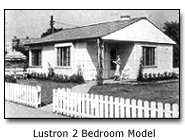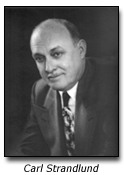 |
 In
1994, buried in a forgotten box in the Ohio State Historical Society,
film producers, Bill Kubota, Ed Moore and Bill Ferehawk discovered a
trail of newspaper clippings, Senate hearing transcripts and internal
Lustron Corporation documents which suggested that the collapse of what
was being called in 1950 the “General Motors of housing” was brought
on not by simple market forces but by a government conspiracy that
reached all the way to the Truman White House. In
1994, buried in a forgotten box in the Ohio State Historical Society,
film producers, Bill Kubota, Ed Moore and Bill Ferehawk discovered a
trail of newspaper clippings, Senate hearing transcripts and internal
Lustron Corporation documents which suggested that the collapse of what
was being called in 1950 the “General Motors of housing” was brought
on not by simple market forces but by a government conspiracy that
reached all the way to the Truman White House.
 Now
for the first time, this crucial juncture in history is explored.
The one-hour documentary, Lustron – The House America’s Been
Waiting For, tells the story of Chicago inventor Carl Strandlund and
his crusade to revolutionize homebuilding by mass-producing steel
houses—100 each day—on an assembly line. Now
for the first time, this crucial juncture in history is explored.
The one-hour documentary, Lustron – The House America’s Been
Waiting For, tells the story of Chicago inventor Carl Strandlund and
his crusade to revolutionize homebuilding by mass-producing steel
houses—100 each day—on an assembly line.
At
the end of World War Two, 12-million war veterans returned to a housing
crisis. Some slept in grain silos, old
streetcars and chicken coops. President Harry Truman seized the
opportunity to force builders and suppliers to concentrate solely on
housing for young families, especially the families of war veterans.
Leading
architects like Frank Lloyd Wright and Buckminster Fuller threw
themselves at the problem The answer: prefabricated housing—a new
industry that would provide a better standard of living to all American
families.
 Every
effort failed but one. It took an industrial genius from Chicago, a
gambler obsessed with the odds, to pull it off. Charming and
relentlessly enthusiastic Strandlund won over congressmen, bureaucrats
and even President Truman. He negotiated landmark labor agreements with
national trade unions that saw housing as America’s great new
industry. Armed with 37 million tax dollars, Carl Strandlund risked
everything he had to mass-produce the American Dream—a dream made of
porcelain-enameled steel called the Lustron home. Every
effort failed but one. It took an industrial genius from Chicago, a
gambler obsessed with the odds, to pull it off. Charming and
relentlessly enthusiastic Strandlund won over congressmen, bureaucrats
and even President Truman. He negotiated landmark labor agreements with
national trade unions that saw housing as America’s great new
industry. Armed with 37 million tax dollars, Carl Strandlund risked
everything he had to mass-produce the American Dream—a dream made of
porcelain-enameled steel called the Lustron home.
 “For
many groups, the idea of mass-producing the world’s biggest
commodity—a house—was an extremely tempting and provocative idea,”
claims producer and architect, Bill Ferehawk. “Lustron
could have been the silver bullet that solved social problems by
providing quality affordable houses for the common man.” “For
many groups, the idea of mass-producing the world’s biggest
commodity—a house—was an extremely tempting and provocative idea,”
claims producer and architect, Bill Ferehawk. “Lustron
could have been the silver bullet that solved social problems by
providing quality affordable houses for the common man.”
 Porcelain-enameled
steel, the same resistant finish found on bathtubs and appliances,
covered all surfaces of the Lustron house. Strandlund planned to roll
them off auto-style assembly lines. In suburban neighborhoods across the
Midwest, the South and Northeast, Lustron houses were popping up at the
rate of one house every four days. The social and economic implications
were enormous. Then, at the threshold of success came an untold tragedy
at the hands of devious conspirators connected to the White House. Porcelain-enameled
steel, the same resistant finish found on bathtubs and appliances,
covered all surfaces of the Lustron house. Strandlund planned to roll
them off auto-style assembly lines. In suburban neighborhoods across the
Midwest, the South and Northeast, Lustron houses were popping up at the
rate of one house every four days. The social and economic implications
were enormous. Then, at the threshold of success came an untold tragedy
at the hands of devious conspirators connected to the White House.
 It
is difficult to avoid comparing Lustron with Coppola’s movie, Tucker:
The Man and His Dream,” remarks Lustron producer Ed Moore.
“Strandlund and Tucker both made the better mousetrap and both were
toppled by politics and corruption in Washington.” It
is difficult to avoid comparing Lustron with Coppola’s movie, Tucker:
The Man and His Dream,” remarks Lustron producer Ed Moore.
“Strandlund and Tucker both made the better mousetrap and both were
toppled by politics and corruption in Washington.”
“The
story is a revelation,” says Tom Beeby, former dean of the Yale School
of Architecture, “that manufactured housing can actually be done and
it dispels the myths surrounding the failures of manufactured housing.”
Perhaps producer Bill Kubota sums it up best, “Lustron was a
tragedy. Lustron’s failure had nothing to do with great ideas and
everything to do with politics.”
|


